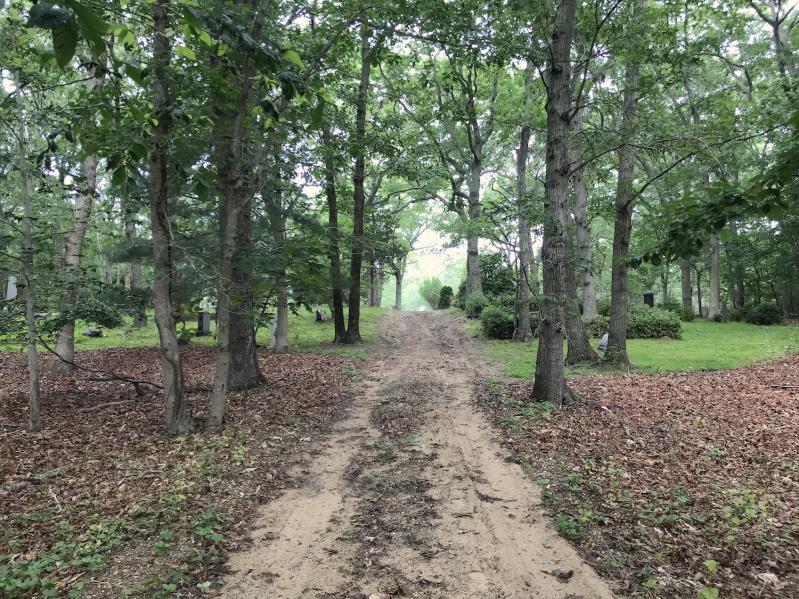When I die, I don’t want a gravestone over some refrigerator-size plot of grass to mark my existence, but instead, a birdbath, or shallow basin, full of water. I’ll always have visitors. That’s what I was thinking before the thoughts escaped my mouth as words, as I passed a stone bath in Green River Cemetery in Springs, where I walked with Irene Silverman, an editor at the paper, last week.

We were birding, sort of, through the haphazard collection of stones, each bringing a flash of memory to Irene. Sparrows, chipping and song, sang. We walked through light and shade, the sound of disturbed gravel beneath our feet. A turkey vulture was only a black mark gliding across the high blue sky, wiped clean by north winds.
Now, I’m no historian, and while I’m fascinated by the stories contained within cemeteries, those are for another article. I walked our local cemeteries with one goal; to escape the summer crowds, the ego of this place, and quietly contemplate a bird or two. Green River was the fifth cemetery I had visited, and with Oakland Cemetery in Sag Harbor, the best place to bird.
That said, summer is perhaps the worst time of year to bird. Most birds are busy nesting. Their spring feathers are fading, and their songs grow scarce compared to April and May. The trees are thick with leaves, so while you may hear baby birds, you rarely see them, and even adult birds are difficult to find. You’re birding but you’re not really birding. Leave your binoculars at home. Leave your iPhone and Merlin app in the car. This is not for that. Instead, stroll through the cemetery, grow thoughtful, and let the birds, many of which will live only a few years (think of that!), be your soundtrack.
If you know what’s singing, great! However, instead of separating songs into Bird A, Bird B, Bird C, see if you can let the birds simply be a sound alphabet, a word scramble. Try to do this John Cage-type thing and just let it all be music; one song that begins when you exit your car, and ends when you re-enter it and pick your damn phone back up.
A criminally quick note on the also-rans: Bridgehampton Cemetery — too loud, too exposed, too maintained. Sagg Cemetery in Sagaponack — great for flyovers but small more an incidental stop returning from Sagaponack Pond than its own destination. Most Holy Trinity Catholic Cemetery in East Hampton features a back meadow that borders on the LongHouse Reserve, but it’s too narrow and neat. (That said, my daughter and I watched a red-winged blackbird feed a fledge there.) Shaarey Pardes is apparently beautiful and park-like, but not open to the public.
Green River Cemetery is quiet. There are no busy roads nearby and a random vibe permeates this non-denominational place. A gravel road in the shape of an incomplete figure-eight frames the grave areas. At the end, you either retrace your steps, or meander up through the stones to complete the number. Meander. The bonus is that doing so leads you past Jackson Pollock’s grave, a large cut boulder on a rise. He was buried in 1956. After that, a sort of graveyard land rush happened, and the place, previously a local cemetery home to familiar Bonacker names, also became the underground home of equally familiar artists, actors, writers, and poets.
The sky near Mr. Pollock’s stone is wide, affording good views for flyover birds and indeed, as Irene and I watched, a glossy ibis flew north, probably to the Merrill Lake Sanctuary, just a mile and a half away. Bird references abound: two birdbaths, and on a Miller family headstone is carved the truth, “We all fly away someday.” On the composer Stefan Wolpe’s headstone an inscrutable inscription, “A thousand birds will fly out of my mouth when I die.”

I wasn’t in a contemplative mood when I drove through the rusted iron gates at the Oakland Cemetery in Sag Harbor, but carpets of thick moss from which massive oak trees grew, with gravestones as seedlings, changed that. This is the best cemetery for a quiet walk. It’s 26 acres, and if you go up and down every road and circumambulate, you can walk a couple of miles.
Narrow footpaths, only a few feet wide, connect the larger arteries, and are charmingly ill maintained. They’re full of moss and weeds, which probably means come autumn this place will hold many sparrows. A Carolina wren sang near the broken mast monument, and there were birdbaths, birdhouses, and even a bird feeder (empty) among the graves.
However, it’s the back section of the cemetery that holds the greatest potential for birds. An eastern phoebe and a great-crested flycatcher sang from a cleared area, full of wood chips, guarded by towering trees. If, like a bird, you could lift up and over those trees, you’d be looking down on Round Pond and past that, to the Long Pond Greenbelt, to the Atlantic Ocean, and to the horizon. It’s not a bad place to be.

